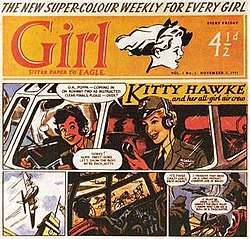Girl (UK comics)
Girl was a weekly comic magazine for girls published from 1951 to 1964. It was launched by Hulton Press on 2 November 1951 as a sister paper to the Eagle, and lasted through Hultons' acquisition by Odhams Press in 1959 and Odhams' merger into IPC in 1963. Its final issue was dated 3 October 1964, after which it was merged into Princess. Another comic of the same name was published by IPC from 1981 to 1990, during which time Dreamer and Tammy were merged into it.[1] Girl was very much an "educational" magazine whose heroines, including those who got into scrapes, became involved in tales which had a moral substance. A considerable number of pages were also dedicated to real life tales of heroic women in various fields.
| Girl | |
|---|---|
 The cover of Girl issue 1, featuring "Kitty Hawke and her All-Girl Air Crew", 1951 | |
| Publication information | |
| Publisher | Hulton Press, Odhams Press, IPC |
| Schedule | Weekly |
| Format | Ongoing series |
| Publication date | 2 November 1951 – 3 October 1964 |
| Editor(s) | Marcus Morris, Jean Crouch |
Original series
Like the Eagle, Girl was founded by the Rev. Marcus Morris. The lead strip was originally "Kitty Hawke and her All-Girl Air Crew", drawn in full colour by Ray Bailey, about a group of women running a charter airline. The strip was not very popular - it was apparently felt to be too masculine - and it was moved to the black and white interior pages, replaced on the cover by the schoolgirl strip "Wendy and Jinx", written by Michael and Valerie Hastings and drawn by Bailey.[2][3][4]
Other strips included:
- "Angela Air Hostess", written by Betty Roland and drawn by Dudley Pout (1958-1961)[5]
- "At Work With Janet - Fashion Artist", drawn by Marjorie Slade[6]
- "Belle of the Ballet" by George Beardmore and Stanley Houghton[7]
- "Captain Starling" by George Beardmore and Paddy Nevin[8]
- "Claudia of the Circus", written by Geoffrey Bond and drawn by T. S. La Fontaine[9]
- "A Cosy Christmas", drawn by Gerald Haylock[10]
- "Emergency Ward 10", based on the TV series, drawn by Eric Dadswell[11]
- "Flying Cloud", a western strip, written by Charles Chilton[12]
- "Judy and Pat", illustrated by Harry Winslade[13]
- "Laura and the Legend of Hadley House" by Betty Roland and Dudley Pout (1954)[5]
- "Lettice Leefe" - the greenest girl in the school, by John Ryan[14]
- "Lindy Love" by Ruth Adam and Peter Kay (1954–55)[15]
- "Pat of Paradise Isle" by Betty Roland and Dudley Pout (1953-1954)[5]
- "Penny Starr, written by Peter Ling and Sheilah Ward, 1957[16]
- "Prince of the Pampas", drawn by Dudley Pout (1961)[17]
- "The Rajah's Secret" by Betty Roland and Charles Paine[18]
- "Robbie of Red Hall", drawn by Roy Newby[19]
- "Sally of the South Seas" by J. H. G. Freeman and Dudley Pout (1961)[17][20]
- "Sumuna's South Sea Isle" by Terry Standford and Paddy Nevin[8]
- "Susan of St. Bride's", series about a student nurse, by Ruth Adam and Peter Kay (1954-61)[15][21]
- "Tessa of Television"
- "Three Sisters of Haworth", bio of the Brontë sisters, written by Pamela Green and Kenneth Gravett, drawn by Eric Dadswell[11]
- "Travel Girl" by Molly Black and Dudley Pout (1952-52)[17]
- "Two Pairs of Skates", written by Peter Ling and Sheilah Ward (1956-57)[16]
- "The Untold Arabian Nights" by Geoffrey Bond and Cecil Langley Doughty[9]
- "Vicky" by Betty Roland and Dudley Pout (1954-1958)[5]
- "White Queen of Calabar", drawn by Gerald Haylock[10]
- "Yvette" by Sylvia Little and Dudley Pout (1952)[17]
1980s series
References
- Complete AP/Fleetway Comic Index
- Girl Flight! Kitty Hawke and Worrals of the WAAF versus Angela Air Hostess, Gad, Sir! Comics!, 19 September 2007
- "Girl at BritishComics.com". Archived from the original on 2016-03-04. Retrieved 2011-06-26.
- Ray Bailey at Lambiek Comiclopedia
- Steve Holland, Betty Roland, Bear Alley, 8 September 2006
- Marjorie Slade at Lambiek Comiclopedia
- Stanley Houghton at Lambiek Comiclopedia
- Steve Holland Pat Nevin, Bear Alley, 1 May 2008
- Eagle writers - Geoffrey Bond (1920 - 2009) aka Alan Jason, Eagle Times, 31 December 2009
- Gerald Haylock on Lambiek Comiclopedia
- Eric Dadswell at Lambiek Comiclopedia
- Eagle Writers - Charles Chilton (1917 - ), Eagle Times, 30 July 2008
- Harry Winslade at Lambiek Comiclopedia
- John Ryan at Lambiek Comiclopedia
- Peter Kay at Lambiek Comiclopedia
- Steve Holland, Peter Ling (1926-2006), Bear Alley, 21 September 2006
- Steve Holland, Dudley Pout, Bear Alley, 31 January 2007
- Charles Paine at Lambiek Comiclopedia
- Roy Newby at Lambiek Comiclopedia
- Eagle writers: J. H. G. Freeman (1903-1972) aka Gordon Grinstead, Eagle Times, 30 January 2009
- Shu-fen Tsai, "Girlhood Modified in "Susan of St. Brides" in Girl magazine (1954-1961) (pdf), Dong Hwa Journal of Humanistic Studies 2, July 2000, pp. 259-272